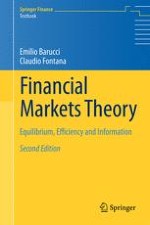2017 | OriginalPaper | Chapter
4. General Equilibrium Theory and No-Arbitrage
Authors : Emilio Barucci, Claudio Fontana
Published in: Financial Markets Theory
Publisher: Springer London
Activate our intelligent search to find suitable subject content or patents.
Select sections of text to find matching patents with Artificial Intelligence. powered by
Select sections of text to find additional relevant content using AI-assisted search. powered by
